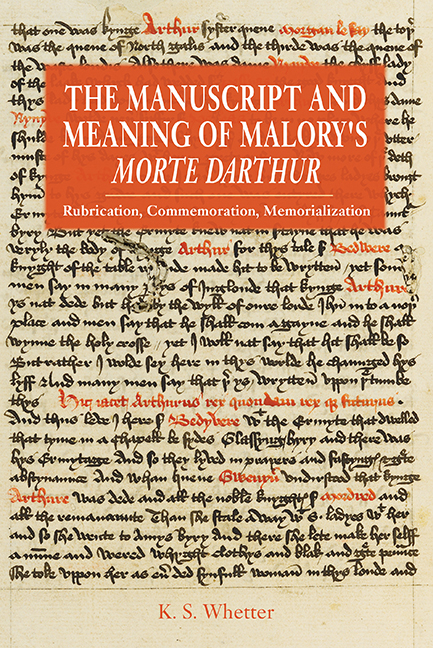Book contents
- Frontmatter
- Dedication
- Contents
- List of Plates
- Acknowledgements
- Abbreviations
- A Note on the Text
- A Textual Introduction
- 1 The Unusual Nature of Winchester's Rubrication
- 2 Tracing Winchester's Rubrication and Marginalia
- 3 Malory's Sacralized Secularity
- 4 Rubricated Elegy
- Conclusion: The Red and the Black
- Bibliography
- Index
- Miscellaneous Endmatter
A Textual Introduction
Published online by Cambridge University Press: 28 April 2017
- Frontmatter
- Dedication
- Contents
- List of Plates
- Acknowledgements
- Abbreviations
- A Note on the Text
- A Textual Introduction
- 1 The Unusual Nature of Winchester's Rubrication
- 2 Tracing Winchester's Rubrication and Marginalia
- 3 Malory's Sacralized Secularity
- 4 Rubricated Elegy
- Conclusion: The Red and the Black
- Bibliography
- Index
- Miscellaneous Endmatter
Summary
Late mediaeval aristocratic culture valued visual spectacle. As Nigel Saul puts it, ‘In the Middle Ages, when literacy was limited, it was through visual display that messages about status were communicated.’London, British Library Additional MS 59678, otherwise known as the Winchester manuscript of Sir Thomas Malory's Le Morte Darthur, despite its lack of miniatures is a visually striking artefact. It is also an artefact in which spectacle and meaning coalesce. It is my contention that the spectacular nature of the Winchester manuscript engages with and reflects the principal themes and characters of the Morte Darthur in ways unprecedented by other secular literary texts and their manuscripts in the Middle Ages. That is, with the Morte Darthur and its manuscript there is a marked and unique correlation between the physical layout of the manuscript text and the major narrative and thematic concerns of the lexical text. Winchester's physical layout, especially its rubrication of each and every character's name, creates a visual exaltation of the glory and splendour of earthly Arthurian chivalry. This close connection between manuscript and narrative is so marked and so unusual that it is much more likely to be authorial than scribal in origin.
Sir Thomas Malory's fifteenth-century Le Morte Darthur is the last major Arthurian work of the Middle Ages and the first and only Arthurian text in Middle English to recount the entire legend of Arthur from his birth to his death. R. M. Lumiansky styles it ‘the outstanding English book of the fifteenth century’, and the Morte's interest for modern scholars and influence upon modern authors and film-makers is sufficient to bear this out. Indeed, Malory's Morte has proven to be the most influential of all mediaeval treatments of the story of Arthur, inspiring a vast array of post-mediaeval authors and film-makers, including Edmund Spenser, Alfred Lord Tennyson, Mark Twain, T. H. White, John Steinbeck, Naomi Mitchison, John Boorman and Peter Ackroyd. Malory himself tells us that his ‘book was ended the ninth yere of the reygne of Kyng Edward the Fourth’ (C XXI.13; 940.26–7): that is, 4 March 1469–3 March 1470.
- Type
- Chapter
- Information
- The Manuscript and Meaning of Malory's Morte DarthurRubrication, Commemoration, Memorialization, pp. 1 - 22Publisher: Boydell & BrewerPrint publication year: 2017

